Imagine a world where the barren wastelands of erstwhile deserts bloom with verdant crops, feeding millions, and all of it made possible by the esoteric world of cryptocurrency. Sounds like a utopian fantasy? Not anymore. Welcome to the new era of agriculture where blockchain technology is not just revolutionizing finance, but also breathing life into the driest corners of the planet.
In recent times, blockchain-enabled irrigation systems have emerged as the unexpected heroes in sustainable agricultural practices, especially in arid regions where water is as precious as gold—or, in our case, Bitcoin. This innovation entails a smart contracting system that allocates and tracks water usage with impeccable accuracy and fairness.
But how does this system work? At its core, the system uses a decentralized ledger to record and verify all transactions without the need for traditional banks. Farmers purchase water rights using digital currency, which then allows them access to a regulated amount of water. Sensors within the irrigation systems measure water flow and usage, automatically updating the blockchain with real-time data, ensuring transparency and accountability.
The perks of such a system are manifold. For one, it eliminates the age-old problem of water theft and unauthorized usage. Thanks to blockchain’s immutability, records cannot be tampered with, making every drop traceable. Additionally, this allows for a more equitable distribution of water, especially crucial in underdeveloped areas that could benefit from agricultural output.
Moreover, blockchain technology enables smart contracts to govern the release of water based on pre-agreed conditions, such as moisture levels in the soil or weather predictions, thus maximizing the efficiency of water use. Gone are the days of indiscriminate watering based on guesswork, making room for an era of precision agriculture.
But the implications don’t stop there. The economic ripple effects are significant. By allowing farmers access to a reliable resource, crop yields are improved, food security is increased, and economies, particularly those in the developing world, receive a much-needed boost. Furthermore, the ease and security of cryptocurrency transactions ensure that farmers in remote locations are not left out from the market due to a lack of traditional banking amenities.
There are notable case studies that highlight the success of such systems. One project in the Sahara, for example, is leveraging cryptocurrency to fund the infrastructure required for blockchain irrigation. Not only does this encourage investments from a global community of eco-conscious crypto investors, but it also fosters a new kind of environmental entrepreneurship.
However, this futuristic agritech does not come without challenges. The primary concern is the digital divide. Lack of access to the necessary technology could exclude some farmers, particularly in developing countries, from reaping the benefits of blockchain irrigation. Awareness and education about cryptocurrencies and blockchain are also necessary to overcome skepticism and fear of the unfamiliar.
In conclusion, the fusion of blockchain and irrigation seems like a match made in heaven for dry regions across the globe. It’s a bold blend of environmental sustainability and cutting-edge technology that might just be the green revolution we’ve been waiting for.
So let’s raise our virtual wallets and toast to the possibility of a world where even the most arid lands can sustain life, all thanks to the innovative synergy of water and blockchain. Who knew cryptocurrency could be so… wet?
